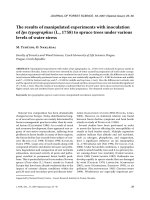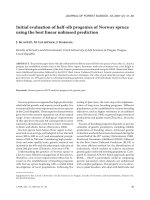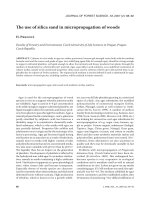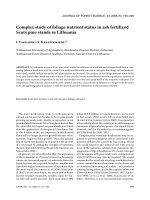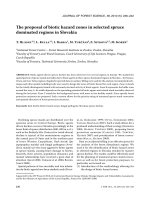Báo cáo lâm nghiệp: "Value production of poplar clones'''' ppt
Bạn đang xem bản rút gọn của tài liệu. Xem và tải ngay bản đầy đủ của tài liệu tại đây (829.78 KB, 8 trang )
J. FOR. SCI., 54, 2008 (6): 237–244 237
JOURNAL OF FOREST SCIENCE, 54, 2008 (6): 237–244
Quality production of wood raw materials with
maximal use of natural factors and minimum costs
of human labour is the main aim of forest production
with regulated management, it means forest cultiva-
tion in its whole production framework. Knowledge
of the value production of forest stands exists on two
levels according to known literary sources. e first
level is the individual financial valuation of the stocks
of concrete stands with their mensurational charac-
teristics, and the second level represents knowledge
in this field for the lifelong development of forest
stands and their total production in the form of
value yield tables. Gross and net financial yield may
be expressed, similarly like traditional yield tables or
assortment yield tables, in dependence on the age
and site index of stands.
In published works the knowledge of the value
production on both levels is available. S
and S (1987) reviewed the production
of Douglas fir, spruce and pine in timber reserve,
proportion of assortments, and gross and net yield.
ey based their own value calculations on standing
resources of the studied tree species, their dimen-
sional sorting, financial valuation of assortments
and costs of logging operations. B
(1991) calculated the gross and net yield of quality
oak stands using the average prices of timber and
costs of logging operations in Bavaria. B
(1986) calculated net yield for beech stands tended
by various methods. B (1989) dealt with the
issue of net yield again, but from the whole forest op-
erations, when he analyzed the results of economic
activities of selected forest enterprises. Based on
their economic records he derived such a minimum
height of total mean increment in m
3
that the net
yield of the whole forest production, including wood
production, is still positive. B (1986) described
the procedure of derivation of value yield tables for
Douglas fir with various tending intensity, yield level
and rotation period. He used yield and assortment
tables for their construction. He used the costs of
logging and other silvicultural operations, including
overhead costs, from the data of forest enterprises.
B (1967) derived tables for the calculation
of net yield from the timber reserve of stands for
spruce, fir, pine, larch, beech, ash and maple. He de-
Value production of poplar clones
R. P, J. M, V. N
National Forest Centre – Forest Research Institute Zvolen, Zvolen, Slovakia
ABSTRACT: e results of research on the value production of the stands of poplar clones Robusta and I-214 carried
out in Slovakia are presented. Models of value yield tables were constructed separately for each clone. e models
simulate gross and net financial yield of wood production in dependence on the site index and age of stand. ey were
constructed on the basis of the models of assortment yield tables, timber prices according to assortments and the mod-
els of own costs of timber felling and processing. e clone I-214 produces a faster and higher proportion of thicker
assortments of average and below-average quality, and therefore it has the higher value production at a younger age
only. Robusta produces smaller diameter but higher quality assortments and has the higher value production only at an
older age. e site index of the stand is the most important factor in the value production of poplar clones. Differences
in the production between site indexes are much greater than between the clones.
Keywords: poplar clones; value production; gross and net financial yield; value yield tables
Supported by the Science and Technology Assistance Agency, Project No. APVT-27-000504.
238 J. FOR. SCI., 54, 2008 (6): 237–244
rived the tables from tree, assortment and tree value
tables. H (1971) studied in the greatest detail
the problem and procedure of the construction of
complete value yield tables with concrete overviews.
He emphasised that the value yield tables were not
only the issue of natural production in kind but also
it was an economic issue as well. erefore the va-
lidity of all similar tables is dependent on the time.
N and P (1972) derived similar value
yield tables for spruce, fir, pine, oak and beech. In
their construction available yield tables, assortment
tables, timber prices according to assortments and
average costs of whole logging operations were used.
Later P and H (1990) derived mathemati-
cal models of value yield tables with a possibility of
continuous updating of economic data for spruce,
fir, pine, oak and beech, and P et al. (1992) for
larch, hornbeam and birch. Recently the models of
the natural production of poplar clones Robusta and
I-214 have been completed also in Slovakia. P
and M (2001, 2005) and P et al. (2008b)
processed their volume and quality production in the
form of models of yield and assortment yield tables.
Value yield tables are their continuation.
e aim of this paper is to present the methodology
of the construction of the models of value yield tables
of poplar clones Robusta and I-214 and to evaluate
the production of both clones by help of the tables.
MATERIALS AND METHODS
Value yield tables characterize the value produc-
tion of tree species very well. ey give the financial
value in Slovak crowns of timber reserve of the main
stand and secondary crop as well as total production
V (SKK) in dependence on their site index SI and age
t according to the relation:
V(SKK) = f(SI, t) (1)
Yield tables comprise the gross yield of wood pro-
duction as the product of the amount of produced
assortments and timber prices, own costs of their
felling, processing and transportation, and the net
yield that is the difference of gross yield and own
costs of logging. Value yield tables of poplar clones
were constructed by the method of simulation from
the models of assortment yield tables, prices of the
assortments of raw timber and costs of logging ope-
rations.
Models of assortment yield tables
They are in the form of mathematical models
(P et al. 2008b) and they show the structure
of assortments SA (m
3
, %), namely the volume in
m
3
or the proportion in % of quality and diameter
classes of logs of the standing volume of the stand in
dependence on its site index SI and age t according
to the relation:
SA (m
3
, %) = f(SI, t) (2)
Assortment yield tables for poplar clones were
constructed by the fusion of models of yield tables
and stand assortment tables, models of quality and
models of damage to stands.
Models of yield tables (P, M 2001,
2005) determine the development of mean diameter
d
v
and standing volume V for the main stand and
secondary crop in dependence on the site index SI
and age t according to the relation:
d
v
= f(SI, t) (3)
V = f(SI, t) (4)
Models of stand assortment tables determine
the structure of assortments V% for poplar stands
(P et al. 2008a) in dependence on their mean
diameter d
v
, quality qua and damage dam to stands
according to the relation:
V% = f(d
v
, qua, dam) (5)
e structure of the assortments is composed of
the quality and diameter classes of logs in accord-
ance with the standard of the Slovakia STN 48 0056
for the qualitative classification of broadleaved round
wood in 2007. e highest quality classes I and II are
intended mainly for the production of industrial ve-
neers, while class II has slightly lower requirements
for the quality of wood than class I. Class I requires a
minimum log diameter of 40 cm and class II requires
20 cm. Quality classes IIIA, IIIB and IIIC represent
high, average and lower quality saw logs with mini-
mum diameter of 20 cm. Pulpwood assortment of
class V is intended mainly for the pulp industry and
class VI is fuel wood. Assortment diameter classes
1–6+ are defined pursuant to their mean diameter
inside bark.
Models of quality stand are expressed by percent-
age proportions of the external stem quality classes
A–C in dependence on the site index. Models of
damage to stands are expressed by percentage pro-
portions of damage to stems according to visible
symptoms on their surface in dependence on the
stand age. Regression models, as regards the model
of quality and the model of damage to stands, were
derived from the measurements in 87 poplar clone
stands.
J. FOR. SCI., 54, 2008 (6): 237–244 239
Prices of raw timber assortments
e price of timber is an important economic
category as it markedly influences the gross yield
of forest stands. It reflects in money mainly the
timber utility value but in market economy it is
considerably affected also by the supply of and
demand for concrete assortments. e model used
average offering prices of timber for the year 2006
in the locality of dispatching wood yard in three for-
est enterprises – Palárikovo, Levice and Sobrance.
ey have the highest annual cut of poplar wood in
Slovakia. eir values according to quality classes
and diameter classes given in SKK/m
3
are as follows
(Table 1).
As we can see, the prices of poplar wood are rela-
tively low. For example in comparison with spruce
they are lower by about 500–1,000 SKK for higher
quality log assortments and by about 50–400 SKK for
lower quality logs. On the contrary, for pulp assort-
-100
0
100
200
300
400
500
600
700
800
900
1,000
1,100
1 3 5 7 9 11 13 15 17 19 21 23 25 27 29 31 33 35
Age (years)
Yield in thousands SKK
Gross yield Net yield
Site index
40
30
40
20
30
20
-100
0
100
200
300
400
500
600
700
800
900
1,000
1 3 5 7 9 11 13 15 17 19 21 23 25 27 29 31 33 35
Age (years)
Yield in thousands SKK
Gross yield Net yield
Site index
40
30
40
20
30
20
Fig. 1. Robusta – the gross and net yield of the main stand in
dependence on site index and age
Fig. 2. I-214 – the gross and net yield of the main stand in
dependence on site index and age
Table 1. Values according to quality classes and diameter classes (SKK/m
3
)
Quality
class
Diameter class 1–6+
1 2 3 4 5 6+
I – – 2,717 2,767 2,800
II – 2,133 2,200 2,233 2,267 2,300
IIIA 1,303 1,406 1,513 1,553 1,553 1,483
IIIB 1,243 1,303 1,369 1,369 1,369 1,303
IIIC 1,250 1,250 1,250 1,250 1,250 1,250
V 1,075
VI 777
-100
0
100
200
300
400
500
600
700
800
900
1,000
1 3 5 7 9 11 13 15 17 19 21 23 25 27 29 31 33 35
Age (years)
Yield in thousands SKK
Gross yield Net yield
Site index
40
30
40
20
30
20
-100
0
100
200
300
400
500
600
700
800
900
1,000
1 3 5 7 9 11 13 15 17 19 21 23 25 27 29 31 33 35
Age (years)
Yield in thousands SKK
Gross yield Net yield
Site index
40
30
40
20
30
20
-100
0
100
200
300
400
500
600
700
800
900
1,000
1 3 5 7 9 11 13 15 17 19 21 23 25 27 29 31 33 35
Age (years)
Yield in thousands SKK
Gross yield Net yield
Site index
40
30
40
20
30
20
-100
0
100
200
300
400
500
600
700
800
900
1,000
1 3 5 7 9 11 13 15 17 19 21 23 25 27 29 31 33 35
Age (years)
Yield in thousands SKK
Gross yield Net yield
Site index
40
30
40
20
30
20
Yield (thousands SKK)
Yield (thousands SKK)
Site index Site index
30
40
30
20
20
40
– –
240 J. FOR. SCI., 54, 2008 (6): 237–244
ments and fuel wood poplar wood has higher price
by 200–180 SKK.
Timber felling costs
ey are own production costs of whole logging
operations, i.e. timber felling, its skidding, han-
dling and transport as well as other logging costs.
Own costs consist of direct costs, which are mainly
labour costs and material costs for whole logging
operations, and indirect costs related with logging
organization and securing. Labour costs are based
on work standards of 1992 that set the standardized
time consumption in standard hours (SH/m
3
) for
the production of 1 m
3
of raw wood in a concrete
logging operation. In timber felling the time con-
sumption is a function of site index and average
volume of exploited trees, in skidding, handling and
transportation of wood it is only the average volume
of stems or their logs. All other data being necessary
for the calculation of logging costs were obtained
from records of two forest enterprises Palárikovo
and Levice or from accounting records of national
state forest enterprise for the year 2006. In timber
skidding extraction of stems to the distance of 40 m
and hauling of load to the distance of 300 m are taken
into account, while transportation means timber
transport to the distance of 27 km. With regard to
difficult conditions where concrete working opera-
tions are performed, surcharges to the basic standard
hours (SH/m
3
) were added, for timber felling on av-
erage 30%, timber skidding 40% and timber handling
20%. e direct costs of the production of 1 m
3
of
raw wood assortments were derived by means of the
product of SH/m
3
with the wage schedule and coef-
ficient of recalculation of labour costs to direct costs.
Direct costs of other logging activities in SKK/m
3
,
consisting mainly of maintenance and care about the
forest road network, were taken from the accounting
of national state forest enterprise for the year 2006.
Based on these data the coefficient of recalculation
of direct costs to own costs was also derived.
RESULTS AND DISCUSSION
Final quantity of value yield tables is the gross and
net yield of main stand, secondary crop and total
production. Of these three production components
-100
0
100
200
300
400
500
600
1 3 5 7 9 11 13 15 17 19 21 23 25 27 29 31 33 35
Age (years)
Yield in thousands SKK
Robusta I - 214
Site class
40
30
40
20
30
Fig. 3. Comparison of the net yield of the main stand of the
clones Robusta and I-214
Fig. 4. Robusta – the net yield of total production (TP), main
stand (MS) and sum of secondary crop (SSC)
-100
0
100
200
300
400
500
600
700
800
900
1,000
1 3 5 7 9 11 13 15 17 19 21 23 25 27 29 31 33 35
Age (years)
Yield in thousands SKK
Gross yield Net yield
Site index
40
30
40
20
30
20
-100
0
100
200
300
400
500
600
700
800
900
1,000
1 3 5 7 9 11 13 15 17 19 21 23 25 27 29 31 33 35
Age (years)
Yield in thousands SKK
Gross yield Net yield
Site index
40
30
40
20
30
20
Yield (thousands SKK)
Yield (thousands SKK)
Robusta
I-214
-100
0
100
200
300
400
500
600
700
800
1 3 5 7 9 11 13 15 17 19 21 23 25 27 29 31 33 35
Age (years)
Yield in thousands SKK
TP MS SSC
Site index
40
40
30
20
20
30
40
-100
0
100
200
300
400
500
600
700
800
900
1,000
1 3 5 7 9 11 13 15 17 19 21 23 25 27 29 31 33 35
Age (years)
Yield in thousands SKK
Gross yield Net yield
Site index
40
30
40
20
30
20
-100
0
100
200
300
400
500
600
700
800
900
1,000
1 3 5 7 9 11 13 15 17 19 21 23 25 27 29 31 33 35
Age (years)
Yield in thousands SKK
Gross yield Net yield
Site index
40
30
40
20
30
20
MS
TP
SSC
–
–
30
40
30
Yield (thousands SKK)
J. FOR. SCI., 54, 2008 (6): 237–244 241
the main stand is decisive (according to the volume).
Figs. 1 and 2 illustrate its gross and net yield for both
clones. It is obvious that the curves of gross yield
have a shape similar to growth curves, according to
which Robusta reaches the values higher only by 10%
than are the values of I-214. e curves of net yield
also have a similar shape with the exception of the
sections with lower age. It is so because at a younger
age this yield is negative with the values within 20 to
40 thousand SKK. Positive yields are reached for the
highest site indexes at the age of 7–8 years, for inter-
mediate site indexes at the age of 11–12 years and
for the lowest site indexes at the age of 25–26 years,
which is relatively late. At an older age the net yield
of both clones also increases fluently according to
the typical growth curve. At the age of 35 years and
for site indexes 20, 30, 40 the net yield accounts for
about 15%, 50% and 55% of the value of gross yield.
A more detailed comparison of the net yield of main
stands of both clones is presented in Fig. 3. It is obvi-
ous that clone I-214 has a slightly higher yield than
Robusta only at a younger age. For site indexes 20, 30
and 40 the yields of both clones are equal at the age
of about 30, 20 and 17 years. At the age of 35 years
Robusta reaches about 40–590 thousand SKK and
I-214 less only by about 10–70 thousand SKK.
Proportions between the net yields of main stand,
secondary crop and total production are illustrated
in Fig. 4 for Robusta and in Fig. 5 for I-214. It is obvi-
ous that the secondary crop has the lowest values,
when even for the highest site indexes the yields are
only about 300 thousand SKK. Below-average site
indexes of secondary crop have the yield negative in
their whole age range. erefore also the yield from
total production is lower for these site indexes than
is the yield of the main stand. e yields of second-
ary crop with the average and highest site indexes
account for about 15–25% of the yields of total pro-
duction at the age of 35 years. Remaining 85–75% is
the proportion of the main stand.
Total current and total mean increments were
derived from total production. Looking at Figs. 6
and 7 we can state that both clones have very similar
shapes of increment curves. Robusta has the culmi-
nation of increments in several years later as well
as it reaches higher increments at an older age than
0
5
10
15
20
25
30
35
40
1 3 5 7 9 11 13 15 17 19 21 23 25 27 29 31 33 35
Age (years)
Value in thousands SKK
TCI TMI
Site indexa
40
20
30
20
-100
0
100
200
300
400
500
600
700
1 3 5 7 9 11 13 15 17 19 21 23 25 27 29 31 33 35
Age (years)
Yield in thousands SKK
TP MS SSC
Site index
40
40
30
20
20
30
40
Fig. 5. I-214 – the net yield of total production (TP), main
stand (MS) and sum of secondary crop (SSC)
Fig. 6. Robusta – the net yield of total current increment (TCI)
and total mean increment (TMI)
Yield (thousands SKK)
-100
0
100
200
300
400
500
600
700
800
900
1,000
1 3 5 7 9 11 13 15 17 19 21 23 25 27 29 31 33 35
Age (years)
Yield in thousands SKK
Gross yield Net yield
Site index
40
30
40
20
30
20
-100
0
100
200
300
400
500
600
700
800
900
1,000
1 3 5 7 9 11 13 15 17 19 21 23 25 27 29 31 33 35
Age (years)
Yield in thousands SKK
Gross yield Net yield
Site index
40
30
40
20
30
20
MS
TP
SSC
–
-100
0
100
200
300
400
500
600
700
800
900
1,000
1 3 5 7 9 11 13 15 17 19 21 23 25 27 29 31 33 35
Age (years)
Yield in thousands SKK
Gross yield Net yield
Site index
40
30
40
20
30
20
-100
0
100
200
300
400
500
600
700
800
900
1,000
1 3 5 7 9 11 13 15 17 19 21 23 25 27 29 31 33 35
Age (years)
Yield in thousands SKK
Gross yield Net yield
Site index
40
30
40
20
30
20
TCI
TMI
Yield (thousands SKK)
30
40
30
20
20
242 J. FOR. SCI., 54, 2008 (6): 237–244
I-214. erefore its increments for the intermediate
and highest site indexes are higher by 3–5 thousand
SKK. Much greater differences in the increments are
between site indexes than between clones. While for
the highest site indexes their total current increment
culminates at the age of 12–13 years with the value
34–37 thousand SKK, for the lowest site indexes the
culmination is at the age of 30–35 years with the
value only 3–5 thousand SKK. e culmination of
total mean increment is logically at an older age than
the culmination of total current increment. For the
highest site indexes it is at the age of 25–30 years,
for intermediate site indexes it is expected after the
limit of 35 years but for the lowest site indexes it is
at a considerably older age.
The value production of the stands of poplar
clones is the final form of its expression. It in-
tegrates volume wood production, structure of
timber assortments, wood prices and their propor-
tions for single assortments as well as the costs of
the production of final assortments of raw timber
from the felling of trees directly in the forest up to
the deliveries of assortments for their industrial
processing. It is obvious from the overview that
the primary production of raw timber assortments
is decisive in the whole technological process. The
site index of forest stand as well as the duration
of production period affects it markedly. Though
we tried to prove more marked differences in the
value production of both clones, the results do
not confirm our expectations. It is a fact that the
clone I-214 has the substantially faster diameter
growth than Robusta as well as very high volume
production. On the contrary, Robusta produces
assortments of higher quality. With regard to
relatively low unit prices of the highest quality as-
sortments the substantially higher production of
high quality timber of Robusta has not reflected in
the value production significantly. Mainly the very
fast growth and earlier culmination of the incre-
ments of clone I-214 are the reasons for preferring
its cultivation to Robusta clone. The range of the
highest site indexes is also significant. Both clones
reach this range under the conditions of Slovakia.
While Robusta reaches maximum site index 42,
then I-214 even 46. With regard to net yield the
costs of the production of final assortments are
not negligible as with average and above-average
site index they account for 50–55% of the value of
gross yield. Reducing production costs, which con-
cerns direct or indirect costs, can increase their net
yields in timber production in poplar stands very
significantly. Based on the constructed models it is
possible to update very operatively or to simulate
the economic part of value production.
The discussion on the accuracy of derived value
production models has to respect that yield table
models (P, M 2001) and models of
stand assortment tables (P et al. 2008b) do
not have any bias. For that reason neither should
value production models have any bias. We an-
ticipate that relatively exact parameters of value
production will be achieved in the biggest files of
stands. On the contrary, the lowest accuracy will
be achieved of individual stands that will be of
stand parameters much more different from model
parameters.
CONCLUSIONS
Methodology of the construction of the models
of value yield tables of poplar clones Robusta and
I-214 is presented. Based on them the production
of both clones is evaluated as well. According to
relation (1) the models of value yield tables give the
monetary value of the standing volume of main stand
and secondary crop as well as total production in
dependence on their site index and age. ey were
0
5
10
15
20
25
30
35
40
1 3 5 7 9 11 13 15 17 19 21 23 25 27 29 31 33 35
Age (years)
Value in thousands SKK
TCI TMI
Site index
40
20
30
20
40
Fig. 7. I-214 – the net yield of total current increment (TCI)
and total mean increment (TMI)
-100
0
100
200
300
400
500
600
700
800
900
1,000
1 3 5 7 9 11 13 15 17 19 21 23 25 27 29 31 33 35
Age (years)
Yield in thousands SKK
Gross yield Net yield
Site index
40
30
40
20
30
20
-100
0
100
200
300
400
500
600
700
800
900
1,000
1 3 5 7 9 11 13 15 17 19 21 23 25 27 29 31 33 35
Age (years)
Yield in thousands SKK
Gross yield Net yield
Site index
40
30
40
20
30
20
TCI
TMI
Yield (thousands SKK)
J. FOR. SCI., 54, 2008 (6): 237–244 243
constructed on the basis of the models of assortment
yield tables according to relation (2), timber prices in
SKK/m
3
and own costs of timber felling, production
of assortments and their transportation for indus-
trial processing. ese economic data were obtained
from the state forest enterprise of the Slovakia for
the year 2006.
Robusta reaches only by about 10% higher gross
yields of main stand than I-214. Net yield presents a
difference between gross yield and the costs of assort-
ment production. Positive values are reached for the
highest site indexes at the age of 7–8 years, for inter-
mediate site indexes at the age of 11–12 years and for
the lowest site indexes at the age of 25 to 26 years. In
the oldest stands with site indexes 20, 30 and 40 the
net yield accounts for only 15, 50 and 55% of the value
of the gross yield. Clone I-214 has only a slightly high-
er yield at a younger age than Robusta. For site indexes
20, 30 and 40 the yields of both clones are the same at
the age of about 30, 20 and 17 years. Robusta reaches
about 40–590 thousand SKK at the age of 35 years and
I-214 less by about 10–70 thousand SKK.
It is obvious from the comparison of the net yield
of main stand, secondary crop and total production
that the secondary crop has the lowest values, when
even for the highest site indexes the yield is only
300 thousand SKK. Below-average site indexes have
the negative yield of secondary crop in the whole
age range. erefore for these site indexes also the
yield from total production is lower than the yield of
the main stand. Yields of the secondary crop for the
average and highest site indexes account for about
15–25% from the yields of total production at the age
of 35 years. e remaining 85–75% is the proportion
of main stand.
Robusta has higher total current increments for
the intermediate and highest site indexes. While for
the highest site indexes their total current increment
culminates at the age of 12–13 years with the value
34–37 thousand SKK, then for the lowest site indexes
the culmination occurs at the age of 30–35 years with
the value only 3–5 thousand SKK. e culmination
of total mean increment is logically at an older age
than the culmination of total current increment.
With the highest site indexes it is at the age of 25 to
30 years, for intermediate site indexes it is expected
immediately after the limit of 35 years but for the
lowest site indexes it is at a considerably older age.
R e fer enc e s
BACHMANN P., 1967. Vereinfachte Wert- und Wertzuwachs-
berechnungen. Schweizerische Zeitschrift für Forstwesen,
118: 561–575.
BARTELHEIMER P., 1991. Ökonomische Aspekte der Eichen-
wirtschaft. Forstwissenschafliches Centralblatt, 110:
185–195.
BERGEL D., 1986. Der Wertertrag von Douglasienre-
inbeständen in Abhängigkeit von Durchforstungsstärke,
Umtriebszeit und Ertragsniveau. Forstarchiv, 57:
129–134.
BRANDL H., 1986. Wie beeinflussen die Aufwendungen
für Bestandespflegearbeiten das Betriebsergebnis bei
einer Buchen-Betriebsklasse? Allgemeine Forstzeitung,
41: 1015–1016.
BRANDL H., 1989. Ergänzende Untersuchungen zur Ert-
ragslage der Baumarten Fichte, Kiefer, Buche und Eiche in
Baden-Württemberg. Allgemeine Forst- und Jagdzeitung,
160: 91–98.
HENGST E., 1971. Ökonomische Überlegungen zur Durch-
forstung des Fichten-Reinbestandes. Archiv für Forstwesen,
20: 71–98.
NYMBURSKÝ B., POLÁK J., 1972. Hodnotové tabulky. In-
formace ÚHÚL Brandýs nad Labem, 15: 7–24.
PETRÁŠ R., HALAJ J., 1990. Teoretické základy zdokonalenia
rastových tabuliek hlavných drevín. [Záverečná správa.]
Zvolen, VÚLH: 152.
PETRÁŠ R., MECKO J., 2001. Erstellung eines math-
ematischen Modells der Ertragstafeln für Pappelklone
in der Slowakei. Allgemeine Forst- und Jagdzeitung, 172:
30–34.
PETRÁŠ R., MECKO J., 2005. Rastové tabuľky topoľových
klonov. Bratislava, Slovak Academic Press: 135.
PETRÁŠ R., MECKO J., NOCIAR V., 2008a. Quality of wood
in the stands of poplar clones. Journal of Forest Science,
54: 9–16.
PETRÁŠ R., MECKO J., NOCIAR V., 2008b. Models of as-
sortment yield tables for poplar clones. Journal of Forest
Science, 54: 227–233.
PETRÁŠ R., MECKO J., HALAJ J., NOCIAR V., PETRÁŠOVÁ
V., 1992. Sortimentačné a hodnotové rastové tabuľky pre
smrekovec, hrab a brezu. [Záverečná správa.] Zvolen, LVÚ:
156.
SCHROEDER G., SEEMANN S., 1987. Ertragskundlich-
ökonomischer Leistungsvergleich der Douglasie mit
Kiefer und Fichte. Beiträge für die Forstwirtschaft, 21:
58–60.
Received for publication February 22, 2008
Accepted after corrections April 2, 2008
244 J. FOR. SCI., 54, 2008 (6): 237–244
Corresponding author:
Doc. Ing. R P, CSc., Národné lesnícke centrum – Lesnícky výskumný ústav, T. G. Masaryka 22,
960 92 Zvolen, Slovensko
tel.: + 421 455 314 231, fax: + 421 455 314 192, e-mail:
Hodnotová produkcia topoľových klonov
ABSTRAKT: V práci sa prezentujú výsledky, ktoré sa dosiahli pri výskume hodnotovej produkcie porastov topoľo-
vých klonov Robusta a I-214 na Slovensku. Skonštruovali sa modely hodnotových rastových tabuliek osobitne pre
každý klon, ktoré simulujú hrubý a čistý finančný výnos z produkcie dreva v závislosti od bonity a veku porastu.
Podkladom pre ich konštrukciu boli modely sortimentačných rastových tabuliek, cien dreva podľa sortimentov
a modely vlastných nákladov na ťažbu a spracovanie dreva. Klon I-214 produkuje rýchlejšie a väčším podielom
hrubšie sortimenty priemernej a podpriemernej kvality, a preto má vyššiu hodnotovú produkciu v nižšom veku.
Robusta produkuje tenšie, ale kvalitnejšie sortimenty a má vyššiu hodnotovú produkciu len vo vyššom veku. Naj
-
významnejším faktorom v hodnotovej produkcii topoľových klonov je bonita porastu. Rozdiely v produkcii medzi
bonitami sú oveľa väčšie ako medzi klonmi.
Kľúčové slová: topoľové klony; hodnotová produkcia; hrubý a čistý finančný výnos; hodnotové rastové tabuľky

